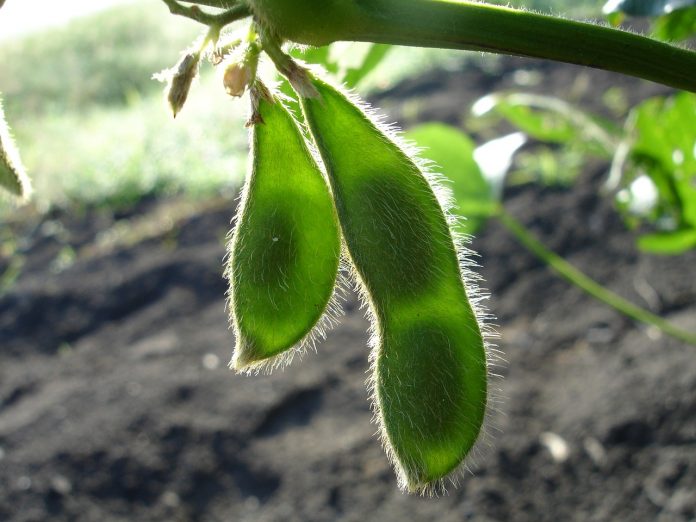By Amy Beth Graves | Contributing Writer
COLUMBUS — Looking to extend the life of your roof at a fraction of the cost? Or a tire that better grips the road surface in all weather conditions? Or a more environmentally friendly form of plastic? All of these products are possible because of the soybean checkoff at the state and national levels.
The list of soy-based products ready on the market is impressive — over 1,000 products ranging from flooring and roofing products to candles to personal care items.
The list keeps growing every year, with the Ohio Soybean Council playing an integral part in helping find new or expanded uses of soybeans since it was established in 1991.
“Farmers don’t want their checkoff money to sit and collect dust. They want it to be productive. They want to invest in projects that show results,” said Kirk Merritt, executive director of the Ohio Soybean Council. “Ohio has absolutely been a leader in this over the years.”
Farmer investments
Every year, Ohio soybean farmers invest 0.5% of the net market price for each bushel of soybeans sold, with half of the funds staying in Ohio and the rest going to the United Soybean Board.
In 2018, the soybean checkoff generated $6.5 million, which was used to fund new product and plant research, expand and develop new markets and educate students about modern agriculture, Merritt said.
About two decades ago, the Ohio Soybean Council and Battelle Memorial Institute started a partnership to create soy biobased products. Later, the soybean council hired long-time Battelle researcher Barry McGraw to serve as its director of product development and commercialization.
Over the past five years, McGraw has overseen efforts to develop and market soy-based products that benefit businesses, consumers and farmers.
Since 2002, the Ohio Soybean Council has been honored 10 times by the R&D 100 Awards program, which recognizes the top 100 innovative technologies of the year, said Jennifer Coleman, the soybean council’s communications director.
“This is the Oscars of innovation,” she said. “It’s very prestigious to win an award, especially since you’re competing on the international stage.”
Research funded by the soybean checkoff has not only helped develop new markets for farmers but reduced fossil fuel consumption, replaced possible carcinogens and satisfied consumer demand for sustainable and environmentally friendly products, Merritt said.
Worth it
As a first-generation row-crop farmer in Highland County, Nathan Brown believes the money he and thousands of other farmers invest in the soybean checkoff every year is worth it.
He talked about the importance of having a diversified market for soybeans, citing concerns about how the United State’s trade war with China will affect Ohio’s soybean market.
In 2017, soybeans were the state’s largest agricultural export, valued at $1.3 billion, according to Ian Sheldon, Ohio State University’s chair in agricultural marketing, trade and policy.
“The checkoff has been very instrumental in building up the market and finding new uses for soybeans. There’s been a lot of product development in Ohio, and diversification of the industry is so important,” he said.
McGraw agreed and said he’s excited to be working directly with farmers and businesses to open up new markets for the soybean industry.
“Soybean farmers want sustainable farms and sustainable products. That’s why they want us to do the research,” he said. “It’s a cool message. Farmers started this research and they’re the ones being sustainable stewards with their land.”
So many uses for soybeans!
Here’s a look at some recent products developed and marketed by the Ohio Soybean Council:

Roof MAXX: An effective and affordable alternative to roof replacement or the application of traditional roof sealants. The product uses an all-natural, soy-based shingle rejuvenator spray to extend the life of aging roofs. One treatment extends the life of a roof by five years for a fraction of the cost of a new roof. The Ohio Soybean Council, Ohio State University and Battelle Memorial Institute worked together on the product, which started in 2017 in Columbus and today is offered in 44 states.

EnzoMeal: This soybean-based fish feed is more nutritious and easier for fish to digest than conventional soybean fish feed because non-digestible carbohydrates have been removed and crude proteins increased. The Ohio Soybean Council worked with Battelle on EnzoMeal, which received a 2017 R&D 100 Gold Special Recognition Award in the corporate social responsibility category. The Ohio Soybean Council is working with Matrix Sea Food India Ltd. to use Ohio soybeans to produce their goal of 50,000 tons of EnzoMeal annually by 2020. EnzoMeal was the first technology the Ohio Soybean Council patented and licensed.
Light Curable Coating: This soy-based floor coating for industrial and aerospace applications is cured with ultraviolet light and dries so quickly that busy places like hospitals and plants don’t need to shut down. It serves as an alternative for epoxies and polyurethanes and meets or exceeds industry targets for appearance, hardness, adhesion, solvent resistance and application temperature. The soy-acylate-based product won a 2018 R&D 100 Award. green soy-acylate-based product.
Other developments:
A Cleveland-area materials provider has tapped into Battelle to replace petroleum-based additives with a soybean alternative. PolyOne Corp. is using Battelle agreed to license its patents for bio-based plasticizers, a compound added to plastic and concrete to increase the materials’ fluidity. Products with plasticizers include plastic blood bags, flexible vinyl swimming pools and children’s toys. Plasticizers are typically petroleum-based.
Global tire and rubber manufacturer Goodyear has introduced the first commercially available passenger car tires made out of a new all-weather performance-enhancing soybean oil-based rubber compound. The new Assurance WeatherReady branded tires was developed by a team of Goodyear scientists and engineers with support from the United Soybean Board.










